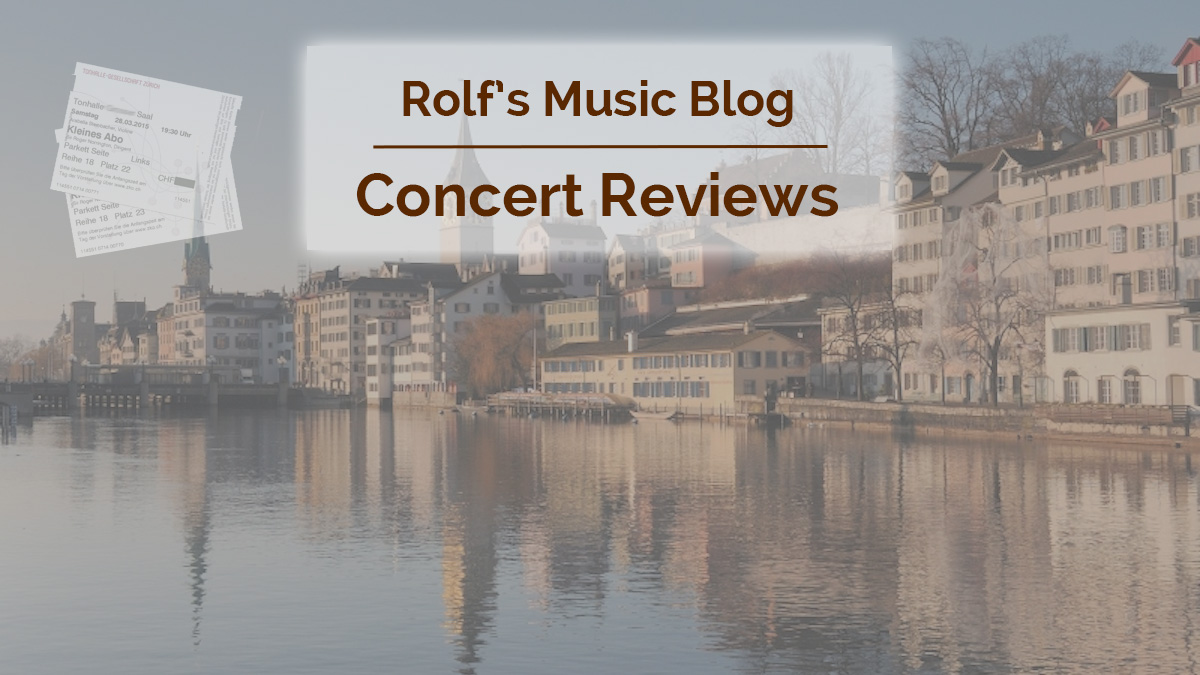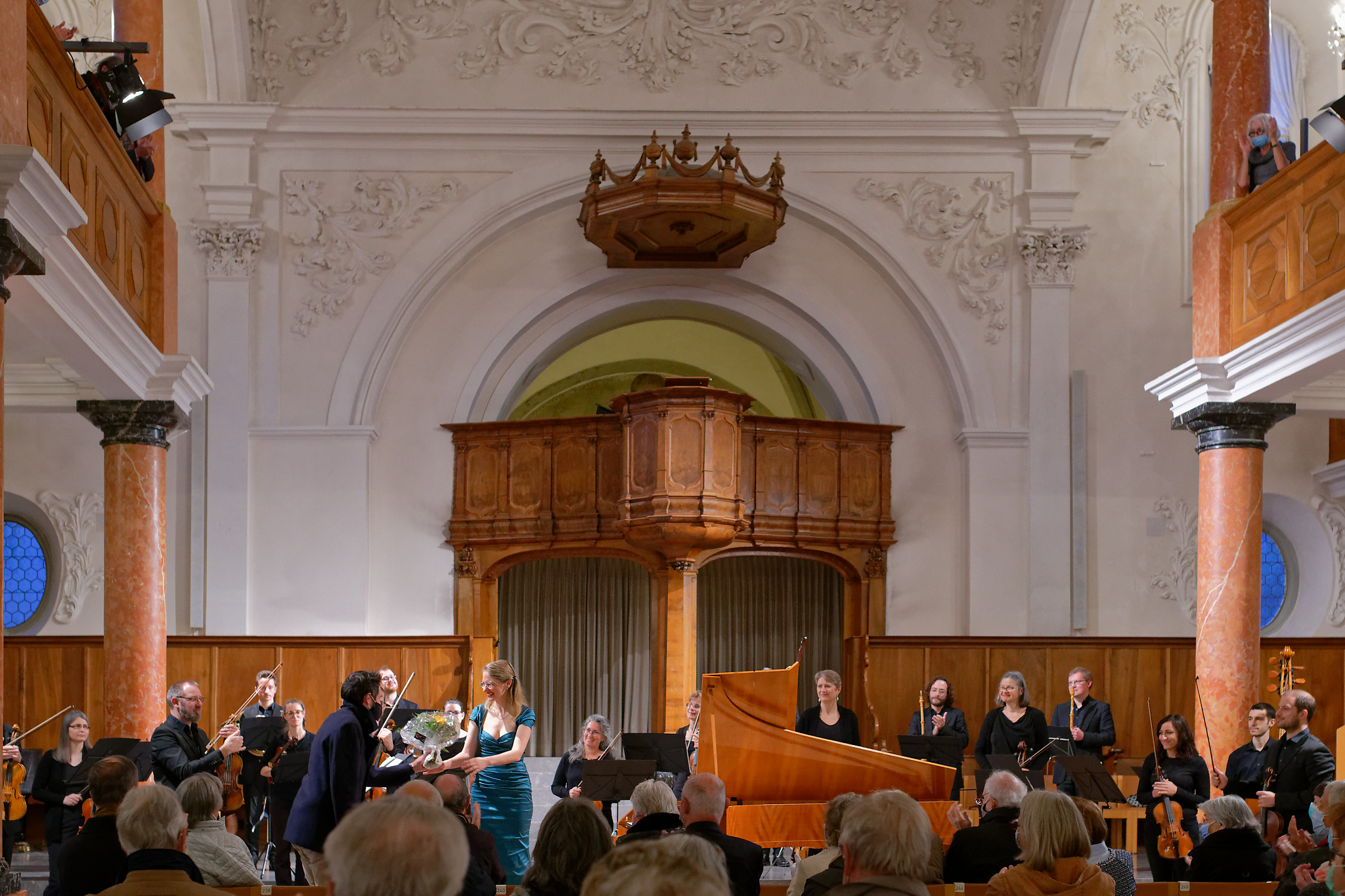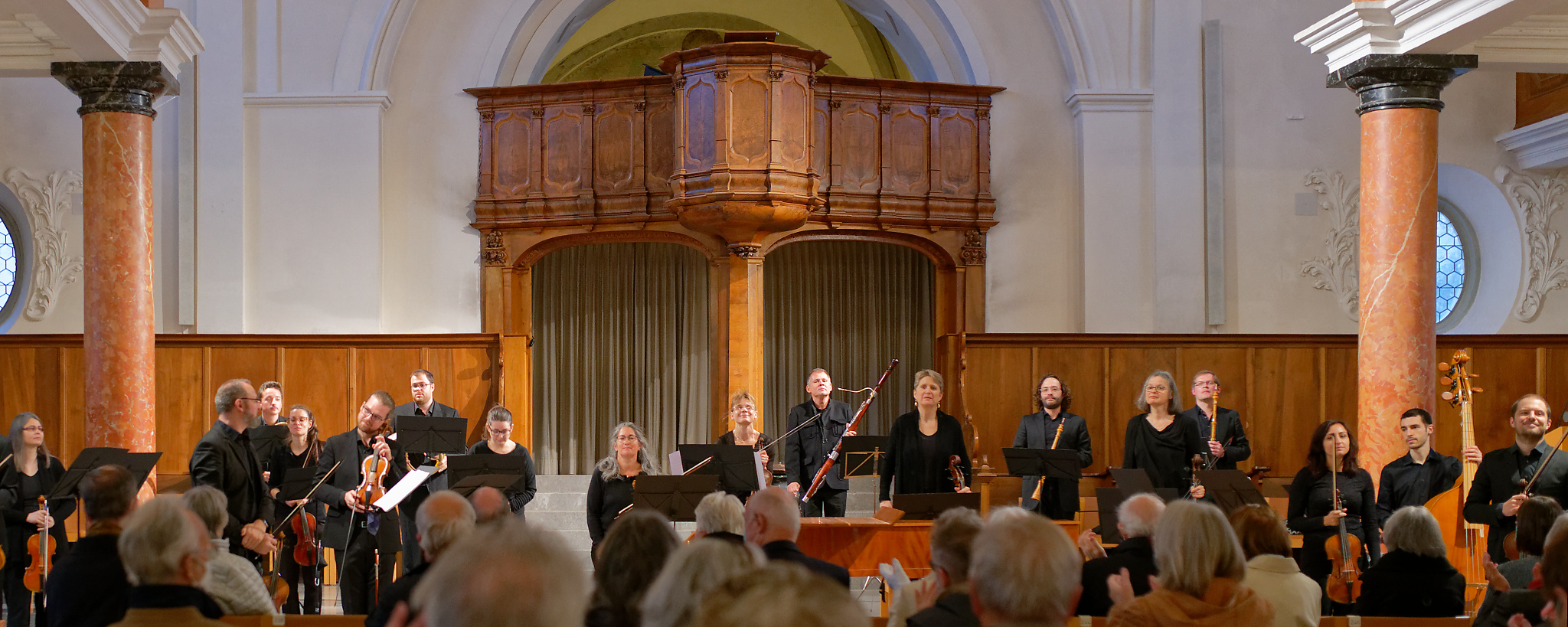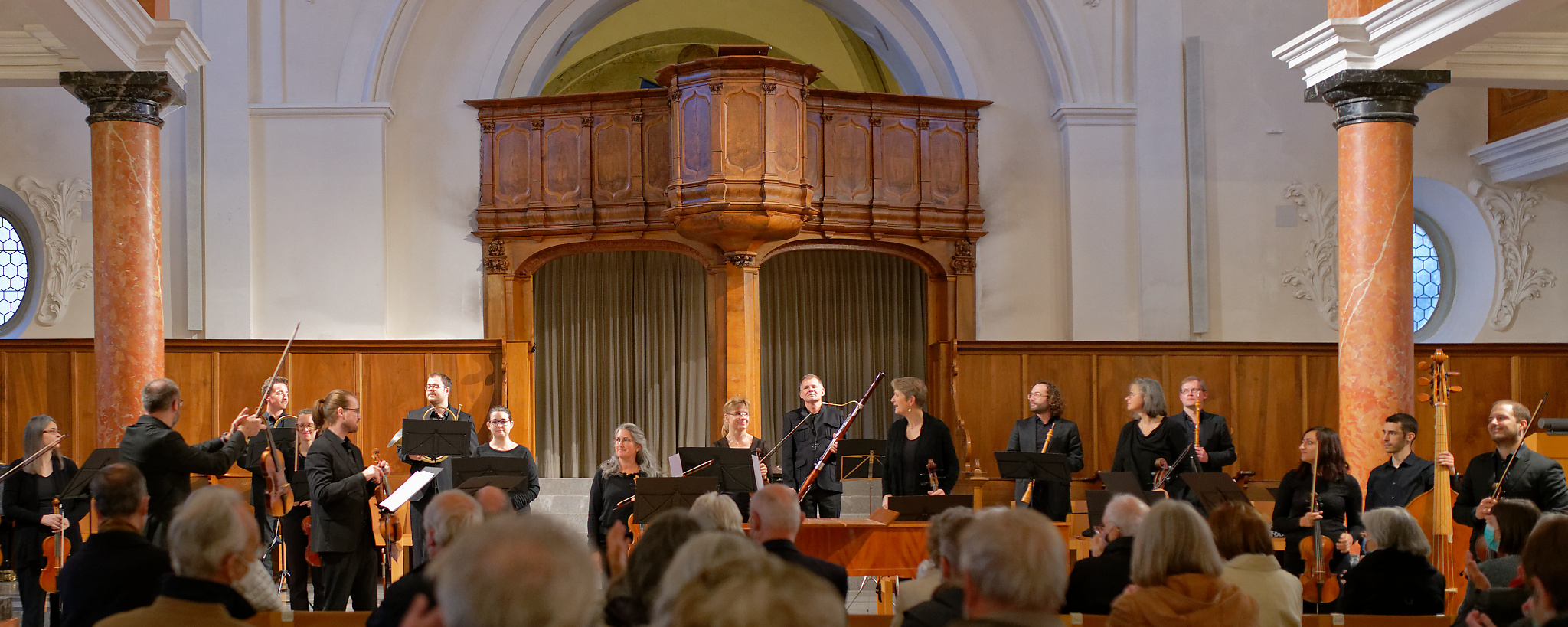Els Biesemans, Dominik Kiefer / Capriccio Barockorchester
Haydn / C.P.E. Bach / Zelenka / Mozart
Kirche St.Peter, Zurich, 2020-10-18

2020-10-24 — Original posting
Tastenkonzerte im Originalklang: Els Biesemans und das Capriccio Barockorchester — Zusammenfassung
Vier Werke standen im Programm des Capriccio Barockorchesters, das am 18. Oktober in der Kirche St.Peter auftrat. Als Einstieg präsentierte das Ensemble auf Originalinstrumenten eine kleine SInfonie: die dreiteilige Ouvertüre zur Oper “Acide e Galatea” des jungen Joseph Haydn. Es ist unterhaltsame Musik der Frühklassik: fröhlich, anspruchslos, und dennoch gekonnt geschrieben. Man hatte den Eindruck, dass die Musiker Artikulation und Dynamik ideal auf die Akustik der Kirche abgestimmt hatten.
Im Konzert in e-moll von Carl Philipp Emanuel Bach präsentierte sich Els Biesemans an einem Hammerklavier nach Anton Walter & Sohn von 1805. Die Pianistin weiß die Möglichkeiten des Instruments zu nutzen: Agilität, Leichtigkeit, ein reiches Farbenspektrum und eine Klarheit, die der moderne Flügel niemals erreichen kann. Das Konzert hat einen wunderschönen Mittelsatz, ist allerdings in den Randsätzen derart sprunghaft und stockend im Fluss (nicht untypisch für C.P.E. Bach), dass der Hörgenuss nicht uneingeschränkt blieb.
Werke des Tschechen Jan Dismas Zelenka sind notorisch schwierig für die Instrumentalisten. Das Capriccio in D-dur macht da keine Ausnahme, verlangt es doch vom ersten Hornisten virtuose Figuren im höchsten Klangregister.
Als Höhepunkt des Konzerts zeigte sich Els Biesemans im Konzert in Es-dur, KV 271 (“Jenamy”, auch “Jeunehomme”) von Wolfgang Amadeus Mozart als Meisterin ihres Fachs: fantasievoll in den Verzierungen und der reichen Agogik, subtil in Dynamik und Anschlag, “sprechend” im Ausdruck, hinreißend im Presto des Schlusssatzes. Das Orchester begleitete äußerst einfühlsam in idealer Balance zum hellen Klang des Tasteninstruments.
Table of Contents
- Introduction
- The Artists
- Program
- Concert & Review
Introduction
| Venue, date & time | Kirche St.Peter in Zurich, 2020-10-18 17:00 |
| Series / Title | “Tastsinn” (Sense of Touch) — Capriccio Barockorchester |
| Organizer | Capriccio Barockorchester |
| Reviews from related event(s) | Previous concerts in this venue; in particular: concert on 2018-03-07 featuring Mozart’s concerto K.271 |
It’s a hampered concert season this year, between two waves of the COVID-19 pandemic, as it turns out. Among the 8 concerts that I attended since this summer so far, five were solo recitals of chamber music. Four of these took place in this location. Even though the venue is ideal not just for solo recitals and chamber music, but equally well suits small, especially baroque orchestral performances. One of these latter instances was a concert back on 2018-03-07, featuring (among other works) a Mozart piano concerto that I was about to hear again in this concert.
The Artists
To me, this concert brought firsts, both on the part of the soloist, as well as with the orchestra:
Els Biesemans, Fortepiano
The name Els Biesemans is not new to me: I have run across her name numerous times over the past year. So far, I only heard her a few years back, in brief performances during one or two of Zurich’s “Organ Walks”: annual, half day strolls through the town of Zurich, with organ recitals (ca. 20 minutes each) in 3 – 5 churches. In fact, Els Biesemans (born 1978 in Antwerp/Belgium, see also the German Wikipedia), is resident organist (Titularorganist) in two of Zurich’s churches (and if I’m not mistaken, I have heard her perform in both these locations).
However, the organ is not Els Bieseman’s only “tool”: she also an avid chamber musician, harpsichordist, pianist and fortepianist. Besides the organ (she also owns a rarity, a “house organ”), the fortepiano has moved into the center of her activities: she not only owns several historic pianos (rather: predecessors of the modern piano, a.k.a. fortepiano), but she even is the organizer of the Zürcher Fortepiano Festival “Flügelschläge“, which she initiated in 2013. This year’s instance is about to happen, on 2020-11-06 through 2020-11-21. Flügelschläge translates to “flappings of wings”. However, it really is not translatable, as Flügel in German stands for a grand piano.
Instrument
In this concert, Els Biesemans performed on one of my all-time favorite keyboard instruments: a fortepiano by Paul McNulty in 2013. It’s a replica of an instrument by Anton Walter & Son from around 1805. The original is now in a museum in Berlin. Yes, the instrument was built slightly after the lifetime of the two piano concerto composers in this concert. However, it is still close enough to the instruments that these composers (C.P.E. Bach and W.A. Mozart) knew, and its sound and performance characteristics are simply outstanding, if not unsurpassed for early classics compositions.
Walter fortepianos have no pedals like modern instruments. Rather, to operate these functions, the artist must push up an upper thigh or a knee against a lever under the keyboard. Els Bieseman’s instrument has three such “pedals”: a shift function (una corda), a moderator, and a forte function. The range of this instrument goes from FF to c4).
Capriccio Barockorchester
The Capriccio Barockorchester is one of the prominent baroque orchestras in Switzerland. Its home is Rheinfelden (canton Aargau), close to Basel. Geographically, the orchestra focuses on performances in Basel and Zurich, as well as of course in its home Canton, in locations such as Aarau, Baden, Beinwil am See, Rheinfelden, Windisch and various others: a set of well-chosen, atmospheric venues.
It was the violinist Dominik Kiefer—now the concertmaster and artistic director—who founded the ensemble in 1999. The ensemble performs on proper baroque instruments (authentic or replicas): baroque string instruments with gut strings, baroque bows, natural horns (cor d’orchestre, with the “crook” located between the instrument and the mouthpiece), and baroque woodwinds (oboes, bassoon).
For this concert, the ensemble featured 4 + 4 violins, 2 violas, 2 cellos violone, 2 oboes, bassoon, and two natural horns. With the exception of the cellos, the orchestra performed standing, violins on the left, followed by cellos, violas, and violone, horns on the rear left, followed by bassoon and oboes. Dominik Kiefer led the ensemble from the first desk.
Program
The program in this concert was under the motto “Tastsinn” (Sense of Touch), obviously referring to the solo instrument. It featured four compositions, without intermission:
- Franz Joseph Haydn (1732 – 1809): Overture in D major to the Opera Fragment “Acide e Galatea“, Hob.Ia:5
- Carl Philipp Emanuel Bach (1714 – 1788): Concerto for Fortepiano and Strings in E minor, Wq.15, H.418
- Jan Dismas Zelenka (1679 – 1745): Capriccio in D major, ZWV 182
- Wolfgang Amadeus Mozart (1756 – 1791): Piano Concerto in E♭ major, K.271, “Jenamy” (“Jeunehomme“)
Setting, etc.
It was the soloist, Els Biesemans, who noticed my blog and my preference for the fortepiano for performances of classical and early classical works. She invited me to this concert—thanks a lot for the opportunity! I was offered a seat in the first row of the rear block in the nave, just under the rim of the organ balcony. With the physical distancing restrictions due to the pandemic, the venue was essentially sold out.
Concert & Review
Haydn: Overture in D major to the Opera Fragment “Acide e Galatea“, Hob.Ia:5
Franz Joseph Haydn (1732 – 1809) composed around 15 operas. Most of these date from his time in which he worked at the court of the Esterházy family, and the majority of these operas are little known today. His Opera “Acide e Galatea” (Hob.XXVIII:1), also referred to as festa teatrale, is one of Haydn’s earliest operas. Haydn composed it in 1763 (revised 1773/1774). The work only survived as a fragment: an Overture in D major (Hob.Ia:5), and four arias. The libretto for the opera is based on a piece “La Galatea” by Pietro Metastasio originates from the Metamorphoses by the Roman poet Publius Ovidius Naso (43 BC – 17/18 AD), as well as older material.
The Overture in D major, Hob.Ia:5, is in three parts (fast – slow – fast). It is written for 2 oboes, 2 horns, and strings. The movements:
- Sinfonia (Overtura) — Allegro molto
- Andante grazioso
- Finale: Presto
The Performance
I. Sinfonia (Overtura) — Allegro molto
Such joyful, light, playful music! Who could write that any better than Haydn? An excellent opening for the concert, for sure! I enjoyed the virtuosity, the clarity, the excellent coordination in the violins (despite the absence of a conductor and the loose setup for the physical distancing). I felt that the light articulation, was ideally matching and interacting with the church acoustics. The orchestra produced a harmonious, warm and well-balanced soundscape, with oboes and the bassoon providing color, at the same time adding clarity to the articulation, the natural horns rounding the tone with a solid foundation.
II. Andante grazioso
A somewhat harmless Intermezzo type movement, cosy, warm-hearted, peaceful, if not comfy. Here, the bassoon proved essential for the clarity, the articulation in the bass (cellos, violone).
III. Finale: Presto
Another movement that is so typical of Haydn: fun, lively, and very short (it’s just an overture for an opera, after all). In its briefness, the performance was enthralling, transparent, virtuosic, clear and transparent: pure pleasure!
Rating: ★★★★
C.P.E. Bach: Concerto for Fortepiano and Strings in E minor, Wq.15, H.418
Carl Philipp Emanuel Bach (1714 – 1788), the fifth child and second surviving son of Johann Sebastian Bach (1685 – 1750), spent most of his life in Berlin and later in Hamburg. With his close to 900 works, C.P.E. Bach was a prolific composer.
Among J.S. Bach’s sons he was the most radical in breaking off from his father’s style and principle. His writing is often described as turbulent and highly expressive (empfindsamer Stil or sensitive style)—and very highly personal. The Concerto for Fortepiano and Strings in E minor, Wq.15, H.418, from his Berlin years (1738 – 1768) is no exception to this. It features three movements:
- Allegro
- Adagio
- Vivace
The Performance
I. Allegro
The orchestral introduction is so typical of C.P.E. Bach: highly expressive, dynamic, full of momentum and drive, even catchy in the theme. Els Biesemans joined the cellos and the violone by harmonizing the continuo, adding contours and character. The composer also set his “watermark” in the surprising general rest in bar 34, prior to the “closing statement”.
As soon as the fortepiano enters with the first solo, however, things change. Let me be clear: Els Biesemans playing was agile, virtuosic, excellent and well-adapted in the ornamentation. However, C.P.E. Bach’s solo part is—”something else”! With the exception of rare quotings of the main theme from the introduction, the solo is—how to put it nicely?—erratic, devoid of any regularity / persistent musical flow, full of sudden disruptions between fast, virtuosic scales and arpeggiando / broken chords. I don’t have a problem with the occasional musical joke. However, to me, this is beyond joking. I can’t blame the soloist, as “making the fortepiano part fluent” would alter the character of the composition and would also be against the notation in the score.
It’s slightly better when the fortepiano’s glittering virtuoso runs serve as link between orchestral interjections. And the second theme is definitely more pleasing, more fluent. But then, the “erratic mode” of course returns. Was the composer trying to depict an extremely capricious primadonna taking over control? I perceived the composition as highly disconcerting, hard to enjoy at all. But again, I can’t blame the soloist, and also the orchestra’s performance left nothing to wish for!
★★★
II. Adagio
A stronger contrast between the first two movements is hardly imaginable! A calm, beautiful melodic invention, almost too nice! It’s somewhat of an ear-worm, almost. It instantly reminded me of the aria “Che farò senza Euridice?” from the opera “Orfeo ed Euridice“ by Christoph Willibald Gluck (1714 – 1787). To the point where I felt that one of the composers must have known the other’s work, if not stolen from it (not the exact melody, but at least the spirit, the atmosphere). Gluck’s opera premiered in Vienna 1762, while Bach’s concerto may well be from the 1740’s, so the flow of ideas (if it so happened) was rather from C.P.E. Bach to Gluck. But OK, Gluck’s aria is much more of an ear-worm. To me, this movement stands above Gluck’s aria!
The Adagio is clearly the centerpiece of the composition! Marvelous, harmoniously blooming in the richly ornamented, highly expressive solo part.
It was an excellent idea to have just two solo violins accompanying the central part of the solo, when the music modulates to a minor key, changing into a somewhat sad, longing, desperate mood. Here, Els Biesemans darkened and softened the tone of the instrument by using the moderator: a “pedal” that inserts a piece of cloth between the hammers and the strings, making them sound darker, softer, and more mellow.
★★★★½
III. Vivace
Here he was again, the typical C.P.E. Bach. The Vivace lives out of the solo part: playful, capricious, often virtuosic with its rolling runs and arpeggiandi. I found it not nearly as erratic as in the first movement, but also not very catchy in the orchestral theme—lacking the brilliant invention? In combination with the solo part, the movement still sounded somewhat heterogeneous, disparate: solo and orchestra don’t really join up to a harmonious unity. Sure, the music has originality. But it is a far cry from the ingenious melodic inventions of someone like Mozart.
On the bright(er) side: the somewhat second-tier quality of the compositions allowed listeners to focus on Els Biesemans’ excellent playing, and of course on the Walter fortepiano, its richness in colors and expressions, the agility of its mechanics. Picturing this music performed on a modern grand seemed impossible!
★★★½
Overall Rating: ★★★½
Zelenka: Capriccio in D major, ZWV 182
The Czech composer Jan Dismas Zelenka (1679 – 1745) grew up in Central Bohemia, received his education in Prague, where he also as a violone player for a short time. From 1710/1711, he became violone player at the renowned Dresden Hofkapelle. From 1716 on he continued his education in Vienna under Johann Joseph Fux (1660 – 1741). In 1719 he returned to Dresden, where he spent the rest of his life. His position was that of a “church composer”, while Johann Adolph Hasse (1699 – 1783) was Hofkapellmeister.
Zelenka was friends and in contact with several prominent composers such as J.S. Bach and his son Wilhelm Friedemann Bach (1710 – 1784). In addition, as teacher, his scholars included composers such as Georg Philipp Telemann (1681 – 1767), Johann Georg Pisendel (1688 – 1755) and Sylvius Leopold Weiss (1687 – 1750).
The Composer
Zelenka’s instrumental works (mostly early compositions) are notoriously challenging, to say the least. It appears as if Zelenka didn’t even remotely consider technical limitations. Maybe (likely), he was writing for the very best instrumentalists of his time. The Capriccio in d major, ZWV 182 (from around 1717) is no exception. It is written for two horns, two oboes, two violins, bassoon and double bass. It features five movements:
- Andante
- Allegro
- Bourrée
- Aria
- Menuett I/II
The score is available from IMSLP.
The Performance
I. Andante
With this music, we were instantly taken back into the domain of baroque music: a beautiful movement, with a calm, stepping bass line. Again, the bassoon added color, poignancy and contours to the bass line. Violins and oboes added in two voices in canon-like fashion: solemn, peaceful, slow melodies in long phrases—simply beautiful!
★★★★
II. Allegro
A baroque fugue, essentially in three voices, with an excellent melody as theme. Just the ending is a little abrupt, unexpected.
One key aspect here, however, was that we got a first flavor of the challenges that Zelenka added for instrumentalists. For the most part, the two natural horns play colla parte with other voices, but in the middle of the movement, the first horn features a long sequence (4 bars) of rolling semiquaver figures from E’ up to A”. One could feel the challenge. Obviously, the horn part is reaching the limits of what is doable even for an excellent instrumentalist.
★★★
III. Bourrée
The Bourrée is easier: a dance movement with two violin voices (oboes colla parte) and a bass line—unexcited…
★★★½
IV. Aria
Here, the challenges for the first hornist return, with a semiquaver line in the second part that moves up to A” (a full bar), then rolls down to D’ again. The hornist managed that well. However, in the second pass, the full-bar A” received a bar-long trill—not entirely successfully…
★★★½
V. Menuett I/II
The two Menuets seem simpler at the surface, sentimental dance pieces. However, they are again challenging for the two natural horns (Menuet I), as well as for the baroque oboes (Menuet II). Starting the da capo instance of Menuet I with the horns alone was daring. It worked out really well, though.
★★★
All in all, I wonder whether Zelenka just didn’t care about possible difficulties, whether he wanted to challenge the instrumentalists, or whether he indeed wanted to show off the qualities of the orchestra?
Overall Rating: ★★★½
Mozart: Piano Concerto No.9 in E♭ major, K.271, “Jenamy” (“Jeunehomme”)
Wolfgang Amadeus Mozart (1756 – 1791) wrote 27 piano concertos. The Piano Concerto No.9 in E♭ major, K.271, “Jenamy” (a.k.a. “Jeunehomme“) is a composition from 1777 and is among the most well-known of Mozart’s concerti.
- Allegro
- Andantino
- Rondeau: Presto — Menuetto: Cantabile — Presto
For additional information see also my report from a concert on 2018-03-07 in that same venue (but different artists).
The Performance
The return of Els Biesemans to the Walter fortepiano brought a dramatic change. The first seconds, the very first bars instantly demonstrated: a true masterwork of a young genius! Mozart’s melodic ingenuity, his sense for inventive, concise, catchy themes was obvious. It felt like being transported into another universe, and the contrast to the preceding works doubled the listening pleasure, the enjoyment!
I. Allegro
What joy it was to follow Els Biesemans’ rich, lively agogics, the playful, well-fitting ornaments. I also noted the excellent balance between fortepiano and orchestra, the diligent, subtle dynamics in the latter, when the fortepiano had the lead role. The articulation was extra-light in the accompaniment. At the same time, Els Biesemans was always subtle, never tried pushing into foreground. She kept close contact with the orchestra, occasionally giving cues with inconspicuous hand gestures. Especially the p / pp dialogs with the orchestra were pure pleasure to listen to! Simply put: the fortepiano is so much superior to any performance on a modern concert grand—simply incomparable.
The tempo was refreshingly agile, though never too fast or rushed. But even at a relatively fast pace, pianist and instrument performed the fastest ornaments with exceptional clarity. However, the solo part wasn’t just Apollonian serenity and musical perfection: Els Biesemans “spiced up” her part with extra ornaments and little variations and witty ritenuti. Tiny jokes (often unexpected, but always very well-fitting) that kept the listener’s attention.
For the most part, Els Biesemans left it to the orchestra to “brag” with expressive, lively dynamics, marked fp accents: the solo instrument covered the other end of the dynamic scale. Primarily in the cadenza, though, the soloist broadened the expressive / emotional spectrum, ranging from intimate / extra subtle segments (full of marked ritenuti and playful hold-ups) to virtuosic gestures.
II. Andantino
The one thing I regretted here: for the dialog between the two violin voices in the introduction, an antiphonal setup would have offered definitive advantages. But that’s a minor quibble: as soon as the solo part set in, that became a detail. The fortepiano sets a string contrast to the earnest motifs in the orchestra. Els Biesemans turned the solo into an expressive, “talking” narrative—a recitative / aria, so rich in emotions, and equally rich in details, gentle jeu inégal and or arpeggiando playing, subtle variations through playful extra ornaments when a motif is repeated. It’s not just in agility where the fortepiano beats all modern instruments, but also in colors, subtlety, expression and clarity.
Els Biesemans’ cadenza again widened the expressive spectrum, by adding a trace of tragedy and drama, and down to sad, longing moments of utter intimacy, before the instrument retracted to pppp, giving way for the closing gestures.
III. Rondeau: Presto — Menuetto: Cantabile — Presto
Not surprisingly, Els Biesemans did not limit the opening solo to fluent elegance and virtuosity: she maintained her lively agogics, the Klangrede. Yet, she remained careful in the details, and to me, nothing really felt exaggerated or excessive. In the (first) cadenza, I noted not just the almost extravagant agogics, but the care and expression, particularly in the left hand. A stark contrast to the enthralling return of the Rondo theme.
My only quibble: for the violins, the tempo seemed to be at the limit, as some of the quaver figures (e.g., in the Tutti starting at bar 200) sounded somewhat superficial.
The Cantabile insert (Menuetto) is another one of Mozart’s strokes of a genius. It opened up a window into a different scenery. To me, it felt like a look into nature, an idyllic country scene with bird calls, maybe children playing. And Mozart’s cadenza! In Els Biesemans’ hands it felt like meandering around, seeking, seemingly getting lost.
The return of the Presto did not appear as a virtuosic splash or sudden relief. Rather, Els Biesemans took the first solo p, even pp, hence creating a harmonious and gentle transition to the enthralling closure.
Rating: ★★★★½
An excellent performance which stands on a par with that of any other one of today’s fortepianists. At the same time, Els Biesemans maintained originality and individuality, keeping the interpretation highly personal.
Her focus is on the subtle, refined aspects of the instrument, avoiding the “noisy end of the spectrum”, which the Walter instruments (and even more so later developments) certainly also possess. This was a wise decision, considering that the fortepiano she used was built some 14 years after Mozart’s death. The instruments that the composer used must still have sounded closer to the harpsichord (brighter, even lighter, less volume), after all.
Encore and Conclusion
The choice of encore was easy: the enthralling, final Presto from the last movement in Mozart’s concerto. A “sure winner” and excellent closure for this concert!


















